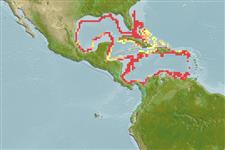Environment: milieu / climate zone / depth range / distribution range
Écologie
marin bathydémersal; profondeur 400 - 500 m (Ref. 1371), usually 400 - 500 m (Ref. 1371). Deep-water; 31°N - 7°N, 98°W - 63°W (Ref. 1371)
Western Atlantic: Florida, USA and northern Gulf of Mexico through Central America to Venezuela.
Taille / Poids / Âge
Maturity: Lm ? range ? - ? cm
Max length : 40.5 cm TL mâle / non sexé; (Ref. 49695)
Description synthétique
Clés d'identification | Morphologie | Morphométrie
Épines dorsales (Total) : 1; Épines anales: 0; Rayons mous anaux: 123 - 125. Body long, compressed, tapering to a fine point posteriorly; anus situated between pelvic fins widely separated from the urogenital opening situated anterior to anal fin origin. A striated light organ is present on the ventral half of the body and on the sides of the head. Pyloric caeca absent. First pelvic fin ray long, filamentous, reaching to anus when depressed. Color is silvery, the dorsal portions slightly brownish, purplish ventrally; oral cavity darker.
Inhabits the outer shelf and upper slopes, on soft bottoms.
Life cycle and mating behavior
Maturities | Reproduction | Spawnings | Egg(s) | Fecundities | Larves
Cohen, D.M., T. Inada, T. Iwamoto and N. Scialabba, 1990. FAO species catalogue. Vol. 10. Gadiform fishes of the world (Order Gadiformes). An annotated and illustrated catalogue of cods, hakes, grenadiers and other gadiform fishes known to date. FAO Fish. Synop. 125(10). Rome: FAO. 442 p. (Ref. 1371)
Statut dans la liste rouge de l'IUCN (Ref. 130435)
Menace pour l'homme
Harmless
Utilisations par l'homme
Pêcheries: sans intérêt
Outils
Articles particuliers
Télécharger en XML
Sources Internet
Estimates based on models
Preferred temperature (Ref.
123201): 8.4 - 16.5, mean 10.6 °C (based on 27 cells).
Phylogenetic diversity index (Ref.
82804): PD
50 = 1.0000 [Uniqueness, from 0.5 = low to 2.0 = high].
Bayesian length-weight: a=0.00339 (0.00129 - 0.00890), b=3.11 (2.89 - 3.33), in cm total length, based on LWR estimates for this (Sub)family-body shape (Ref.
93245).
Niveau trophique (Ref.
69278): 3.6 ±0.3 se; based on size and trophs of closest relatives
Fishing Vulnerability (Ref.
59153): Low to moderate vulnerability (31 of 100).
Nutrients (Ref.
124155): Calcium = 38.7 [19.0, 99.5] mg/100g; Iron = 0.528 [0.209, 1.238] mg/100g; Protein = 16.9 [15.1, 18.6] %; Omega3 = 0.239 [0.104, 0.522] g/100g; Selenium = 16.8 [6.5, 40.8] μg/100g; VitaminA = 18.6 [3.6, 84.5] μg/100g; Zinc = 0.366 [0.228, 0.582] mg/100g (wet weight);
